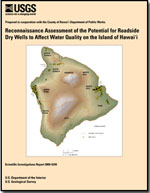The County of Hawai'i Department of Public Works (DPW) uses dry wells to dispose of stormwater runoff from roads. Recently, concern has been raised that water entering the dry wells may transport contaminants to groundwater and affect the quality of receiving waters. The DPW operates 2,052 dry wells. Compiling an inventory of these dry wells and sorting it on the basis of presence or absence of urbanization in the drainage area, distance between the bottom of the dry well and the water table, and proximity to receiving waters helps identify the dry wells having greatest potential to affect the quality of receiving waters so that future studies or mitigation efforts can focus on a smaller number of dry wells. The drainage areas of some DPW dry wells encompass urbanized areas, which could be a source of contaminants. Some dry wells penetrate close to or through the water table, eliminating or substantially reducing opportunities for contaminant attenuation between the ground surface and water table. Dry wells that have drainage areas that encompass urbanization, penetrate to near the water table, and are near the coast have the highest potential to affect the quality of coastal waters (this study did not consider specific sections of coastline that may be of greater concern than others). Some DPW dry wells, including a few that have drainage areas that encompass urbanization, lie within the areas contributing recharge (ACR) to drinking-water wells. Numerical groundwater modeling studies by previous investigators indicate that water infiltrating those dry wells could eventually be pumped at drinking-water wells.
Dry wells that have a high potential for affecting coastal receiving waters or drinking-water wells can be the focus of studies to further understand the effect of the dry wells on the quality of receiving waters. Possible study approaches include sampling for contaminants at the dry well and receiving water, injecting and monitoring the movement of tracers, and numerical modeling. To fully assess whether dry wells actually pose a significant contamination threat to receiving waters, results from modeling or monitoring must be compared to limits for contaminant concentration at receiving waters. These limits are usually established by the agencies tasked with protecting those waters.


